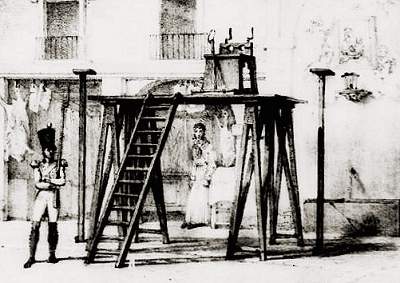an excerpt from
UN AN À ROME ET DANS SES ENVIRONS
(ONE YEAR IN ROME AND IN ITS SURROUNDINGS)
by Antoine-Jean-Baptiste Thomas, 1823 |
In Rome, carnival lasts eight days, which are not consecutive, as they always start on a Saturday, because, out of respect for religious institutions, dances and masquerades are are suspended on Sundays and on Friday before Mardí Gras. These eight days are among the most enjoyable that can be spent in Rome; the most lively gaiety comes with decency, at least apparently, as a strict police keeps good order.
THE SOMARO
Usually, in Rome before Carnival an execution is held. When the latter does not take place, one or more prison convicts are led through some districts of the city. This punishment recalls the exposure at the stool in France. The culprit is placed on a donkey (somaro); his feet are tied by means of a cord under the belly of the animal; very often a rather thick leather collar forces him to keep his head upstraight; his hands are tied behind his back; his chest is covered with a notice on which his name, his offence and his sentence are written; around him hang the instruments that he used for committing the theft, and the stolen objects, as a body of evidence. The donkey is led by one of the executioner's helpers; another helper opens the procession, holding in hand the bull pizzle with which those sentenced to the cavalletto are beaten. The executioner walks behind the culprit; if further somari follow the first one, they are led by men chosen among the common people, dressed as penitents (sacconi), wearing a rough sackcloth.

THE CAVALLETTO (1)
 |
In the morning of the first day of Carnival, a scaffold is set on the same spot where fun is to take place (2). Above this scaffold stands a sort of faldstool, which has a number of openings that can be tightened by means of screws; they receive the extremities of the arms and legs of the patient who, in such forced attitude, turns his back and his loins towards the executioner. The latter, wielding a bull pizzle, lays on the culprit the given number of strokes; if he is too lenient in doing so, he takes his place (3). |
The magistrate, in charge of the police, can condemn whoever disturbs the public order, or causes offence to women, and can enforce the sentence straight away. Followed by a dragoon, he proceeds on horseback along via del Corso for the whole length of time masquerades are held.
1. - During the year, the cavalletto (trestle) punishment is inflicted tho those who carry knives, who play forbidden games in taverns, who duel, etc.; very often the cavalletto is carried to the spot where the offence has been committed.
2. - In 1817, the cavalletto was stood in front of the church of St. Charles, in via del Corso, next to a Madonna shrine; the following year, it was behind the church, in the small piazza degli Otto Cantoni; at nighttime, on both sides of the cavalletto two lanterns (fioccoli) are set. [likely, a mistake for fiaccole]
3. - Foreigners who disturb the public order are taken to prison, until their ambassador intervenes in the issue; only Romans are punished straight away.
|